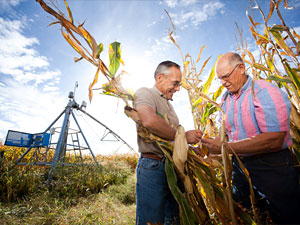Since its inception in 1909, University of Minnesota Extension has worked with farmers to find solutions to their biggest challenges. And, since we all eat—our biggest challenges. For the past 25 years, Extension has shared the U’s expertise by educating agriculture professionals, who in turn have the most influence on crop farmers today.
Keeping agriculture professionals on top of current research helps ensure economically and environmentally responsible cropping decisions are made throughout the state.

Farmer John Dosdall, right, and Crop Consultant Paul Groneberg. Crop farmers learn about the latest University research from ag pros trained by Extension. Image credit: University of Minnesota
It’s a big job, with big impact. According to a 2011 survey, each agriculture professional impacts some 48,000 acres in Minnesota (serving about 61 clients each). That’s about 4.3 million acres across the state and surrounding regions where consultants educated by U Extension have advised farmers.
And with the advancements in so many aspects of agriculture in the past 30 years, farmers need information from a range of professionals—crop consultants, machinery sellers, seed and fertilizer dealers—they all play a role in decisions farmers make every day.
“Agriculture has become a highly complex field, says Paul Groneberg, who works for Centrol—a major crop-consulting enterprise in Minnesota. “Farmers need to pull a lot of pieces together to manage the farm, just like with any other business.”
Consultants like Groneberg build the skills they need to help farmers navigate that complexity through regular participation in Extension’s Institute for Ag Professionals.
John Dosdall grows corn and soybeans near the small town of Hancock in western Minnesota. He says he wouldn’t want to farm today without Paul Groneberg’s advice.
Dosdall says he has made changes in his operation, such as in fertilization, under Groneberg’s guidance. “I apply that knowledge to my cropping system,” he explains. “I don’t put the same application on every part of my field after learning how to determine which nutrients are needed by which areas.”
Harvesting research
By showing real examples from U research lands, specialists like Jeff Gunsolus provide hands-on learning. Gunsolus is an Extension agronomist, professor, and expert in weed-science, and one of the researchers who teach agriculture professionals. Today, he says, herbicide issues are at the forefront of agriculture. Extension makes sure agriculture professionals know the latest about herbicide issues.
“When they can explain to farmers the right herbicide to use on the right weed at the right time, farmers use fewer chemicals,” says Gunsolus. Farm resources are then used more efficiently, weeds develop less resistance, and environmental impacts are reduced. It is a similar situation with managing insect pests, such as the soybean aphid.
In that regard, Extension advocates for using multiple, integrated tactics to control insect pests. An important aspect of this approach is learning to accept a certain amount of pests in a field.
“We’re not into pest eradication,” Extension integrated pest management specialist Bruce Potter explains, “We’re into managing them.”
In the case of the damaging soybean aphid, an Extension team directed a research project involving 11 universities to come up with an aphid threshold: If growers have 250 or fewer aphids per plant, they can leave the pests with absolutely no yield loss.
To simplify the counting of aphids, Extension created a user-friendly tool, which agriculture professionals now learn about and share with farmers.
Developing the agricultural workforce
The model of transferring knowledge to farmers through agriculture professionals has become emulated nationwide because it multiplies the impact of research and education.
It has helped Minnesota become a leader in agricultural production, ranking in the top 10 states in cash receipts from farms and in the export of farm products. Production of food, feed, fiber, and fuel generates more than $75 billion in economic activity every year in Minnesota, and agriculture provides more than 340,000 jobs in the state.
*Source: University of Minnesota
